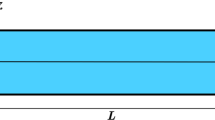Abstract
The feasibility of controlling the stress intensity factors for plane cracks of arbitrary form (distributed in a plane perpendicular to isotropy axis in a transversely isotropic material) which are subjected to symmetric mechanical loading by heating the material is demonstrated by using the congruence theorem and making an analogy between isotropic and transversely isotropic materials based on the theory of thermoelasticity. It is shown that a thermal load which fully compensates for the mechanical load can be created within the range in which the material behaves linearly. If it turns out to be technically impossible to create the necessary thermal load, a simpler temperature regime can be chosen that will “cancel” the mechanical force field with a certain factor of safety.
Similar content being viewed by others
References
A. E. Andreikiv,Three-Dimensional Problems of the Theory of Crakcs [in Russian], Nauk. Dumka, Kiev (1982).
R. V. Gol'dshtein and V. M. Entov,Qualitative Methods in Continuum Mechanics [in Russian], Nauka, Moscow (1989).
V. S. Kirilyuk, “Thermoelastic problems for an isotropic medium with plane normal-rupture cracks,”Prikl. Mekh.,33, No. 1, 52–58 (1997).
V. S. Kirilyuk, “Relationship between problems of the theory of elasticity and the theory of thermoelasticity for isotropic and transversely isotropic media with coplanar cracks during symmetric loading,”Prikl. Mekh.,31, No. 12, 51–60 (1995).
V. S. Kirilyuk, “Control of secondary loading in a material with a discontinuity,”Prikl. Mekh.,28, No. 5, 35–39 (1992).
Yu. M. Kobzar', “Representation of the solutions of static problems of thermoelasticity for a transversely isotropic body,”Tr. XI Conference of Young Scientists of the Institute of Mechanics of the Academy of Sciences of the Ukraine (May 27–30, 1986, Kiilov). Submitted to VINITI July 28, 1986; No. 5507-B, pp. 492–495.
V. V. Panasyuk (editor-in-chief),Fracture Mechanics and the Continuity of Materials: Handbook [in Russian], (Vol. 2,Stress Intensity Factors in Bodies with Cracks, edited by M. P. Savruk), Nauk. Dumka, Kiev (1988).
Yu. N. Podil'chuk, “Stress state and thermal stress state of transversely isotropic bodies with elliptical and parabolic cracks,”Prikl. Mekh.,29, No. 10, 26–36 (1993).
Yu. N. Podil'chuk, “Exact analytic solutions of three-dimensional boundary-value problems of the statics of transversely isotropic bodies of canonical form (Survey),”Prikl. Mekh.,33, No. 10, 3–30 (1997).
Yu. Murakami (editor),Handbook of Stress Intensity Factors [Russian translation], Vol. 2, Mir, Moscow (1990).
H. A. Elliot, “Three-dimensional stress distribution in hexagonal aeolotropic crystals,”Proc. Cambr. Soc.,44, No. 4, 522–533 (1948).
M. K. Kassir and G. C. Sih,Three-Dimensional Crack Problems (Vol. 2,Mechanics of Francture), Nordhoff Int. Publ., Leyden (1975).
Additional information
S. P. Timoshenko Institute of Mechanics, National Academy of Sciences of Ukraine, Kiev. Translated from Prikladnaya Mekhanika, Vol. 35, No. 9, pp. 29–37, September, 1999.
Rights and permissions
About this article
Cite this article
Kirilyuk, V.S. Change in the stress intensity factors for plane cracks in a transversely isotropic medium due to thermal loads. Int Appl Mech 35, 889–896 (1999). https://doi.org/10.1007/BF02682284
Received:
Issue Date:
DOI: https://doi.org/10.1007/BF02682284




